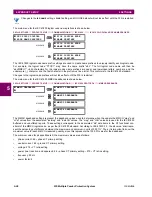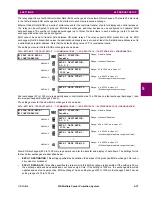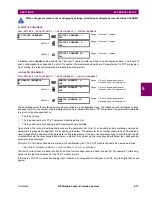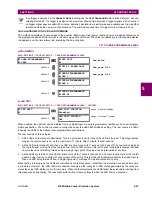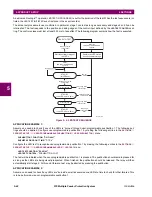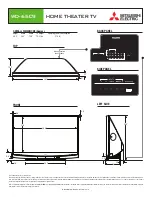
GE Multilin
F35 Multiple Feeder Protection System
5-35
5 SETTINGS
5.2 PRODUCT SETUP
5
The captured data also includes the fault type and the distance to the fault location, as well as the reclose shot number
(when applicable) To include fault duration times in the fault report, the user must enable and configure breaker arcing cur-
rent feature for each of the breakers. Fault duration is reported on a per-phase basis.
The relay allows locating faults, including ground faults, from delta-connected VTs. In this case, the missing zero-sequence
voltage is substituted either by the externally provided neutral voltage (broken delta VT) connected to the auxiliary voltage
channel of a VT bank, or by the zero-sequence voltage approximated as a voltage drop developed by the zero-sequence
current, and user-provided zero-sequence equivalent impedance of the system behind the relay.
The trigger can be any FlexLogic™ operand, but in most applications it is expected to be the same operand, usually a vir-
tual output, that is used to drive an output relay to trip a breaker. To prevent the overwriting of fault events, the disturbance
detector should not be used to trigger a fault report. A
FAULT RPT TRIG
event is automatically created when the report is
triggered.
If a number of protection elements are ORed to create a fault report trigger, the first operation of any element causing the
OR gate output to become high triggers a fault report. However, If other elements operate during the fault and the first oper-
ated element has not been reset (the OR gate output is still high), the fault report is not triggered again. Considering the
reset time of protection elements, there is very little chance that fault report can be triggered twice in this manner. As the
fault report must capture a usable amount of pre and post-fault data, it can not be triggered faster than every 20 ms.
Each fault report is stored as a file; the relay capacity is fifteen (15) files. An sixteenth (16th) trigger overwrites the oldest
file.
Individual fault report features store their files in the same memory space. The sixteenth report will overwrite the first one
regardless which fault report feature produced the sixteenth and the first records.
The EnerVista UR Setup software is required to view all captured data. The relay faceplate display can be used to view the
date and time of trigger, the fault type, the distance location of the fault, and the reclose shot number.
The
FAULT REPORT 1 SOURCE
setting selects the source for input currents and voltages and disturbance detection.
The
FAULT 1 REPORT TRIG
setting assigns the FlexLogic™ operand representing the protection element/elements requiring
operational fault location calculations. The distance to fault calculations are initiated by this signal. The
FAULT REPORT 1 Z1
MAG
and
FAULT REPORT 1 Z0 MAG
impedances are entered in secondary ohms.
The
FAULT REPORT 1 VT SUBSTITUTION
setting shall be set to “None” if the relay is fed from wye-connected VTs. If delta-con-
nected VTs are used, and the relay is supplied with the neutral (3V0) voltage, this setting shall be set to “V0”. The method is
still exact, as the fault locator would combine the line-to-line voltage measurements with the neutral voltage measurement
to re-create the line-to-ground voltages. See the
ACTUAL VALUES
ÖØ
RECORDS
Ö
FAULT REPORTS
menu for additional
details. It required to configure the delta and neutral voltages under the source indicated as input for the fault report. Also,
the relay will check if the auxiliary signal configured is marked as “Vn” by the user (under VT setup), and inhibit the fault
location if the auxiliary signal is labeled differently.
If the broken-delta neutral voltage is not available to the relay, an approximation is possible by assuming the missing zero-
sequence voltage to be an inverted voltage drop produced by the zero-sequence current and the user-specified equivalent
zero-sequence system impedance behind the relay: V0 = –Z0
×
I0. In order to enable this mode of operation, the
FAULT
REPORT 1 VT SUBSTITUTION
setting shall be set to “I0”.
The
FAULT REP 1 SYSTEM Z0 MAG
and
FAULT REP 1 SYSTEM Z0 ANGLE
settings are used only when the
VT SUBSTITUTION
set-
ting value is “I0”. The magnitude is to be entered in secondary ohms. This impedance is an average system equivalent
behind the relay. It can be calculated as zero-sequence Thevenin impedance at the local bus with the protected line/feeder
disconnected. The method is accurate only if this setting matches perfectly the actual system impedance during the fault. If
the system exhibits too much variability, this approach is questionable and the fault location results for single-line-to-ground
faults shall be trusted with accordingly. It should be kept in mind that grounding points in vicinity of the installation impact
the system zero-sequence impedance (grounded loads, reactors, zig-zag transformers, shunt capacitor banks, etc.).
Summary of Contents for F35
Page 2: ......
Page 4: ......
Page 296: ...5 174 F35 Multiple Feeder Protection System GE Multilin 5 9 TESTING 5 SETTINGS 5 ...
Page 328: ...7 8 F35 Multiple Feeder Protection System GE Multilin 7 2 TARGETS 7 COMMANDS AND TARGETS 7 ...
Page 350: ...A 16 F35 Multiple Feeder Protection System GE Multilin A 1 PARAMETER LIST APPENDIXA A ...
Page 422: ...B 72 F35 Multiple Feeder Protection System GE Multilin B 4 MEMORY MAPPING APPENDIXB B ...
Page 472: ...E 12 F35 Multiple Feeder Protection System GE Multilin E 2 DNP POINT LISTS APPENDIXE E ...






